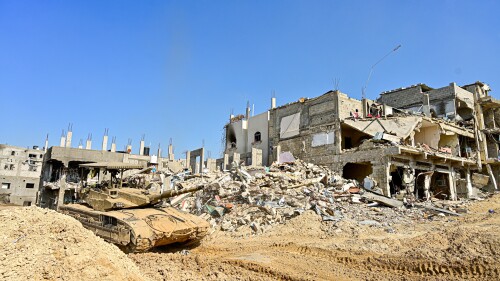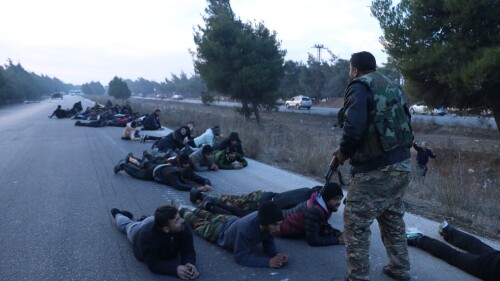Over the past week, violent protests have swept the southern Iraqi city of Basra. Twelve people have been killed in the protests and hundreds injured. The protests focused on the dire living conditions in the city, which is located in a province that is home to 70% of Iraq’s oil reserves. Corruption and chronic mismanagement have produced a daily reality of electricity shortages, lack of drinking water, and high unemployment. There are fears of a cholera outbreak resulting from poor sanitary conditions. Thirty thousand people have been hospitalized after drinking polluted water in recent weeks.
The protests are a violent reaction to all this. No coherent demands or united leadership have yet emerged from the unrest. But the targets of the rioters do not appear to be entirely random.
According to the Arabic-language Asharq al-Awsat newspaper, “Protesters set fire to the building of the neighboring provincial council and a number of party and faction headquarters, including the headquarters of the ruling Dawa Party, the Islamic Supreme Council, the Badr Organization – the largest Shi’ite armed group supported by Iran in Iraq, the headquarters of the Brigades of Imam Ali, and Asaib Ahl al-Haq, led by Qais al-Khazali, and the movement of the former deputy leader Hanan al-Fatlawi. The protesters also attacked offices of the state-run Al-Iraqiya TV and the office of the al-Furat channel of Hakam al-Hakamah, led by Ammar al-Hakim.”
In addition, protesters attacked the facilities of the Kataeb Hezbollah, Khorasani, and Hezbollah al-Nujaba militias.
With the exception of the TV channel, all the above-mentioned targets have one thing in common – they are all clients or proxies of the Iranian regime in Iraq. This orientation of the protests culminated in the burning of the Iranian Consulate in Basra by protesters on Friday, September 7. Protesters chanted “Iran out, Basra remains free,” according to a report in Gulf News.
It is worth noting that Basra is a largely Shia city. The protests were not sectarian in nature. The demonstrators were evidently acting upon a simple and entirely accurate calculation: the situation in the city is intolerable. Those in power are to blame. And the visible power in Iraq today, particularly in the majority-Shia Basra Governorate, is Iran.
The demonstrators in Basra evidently understand something about their country that remains elusive to much Western commentary.
In the aftermath of the military defeat of Islamic State in Iraq, a narrative became widespread in the Western media that a strong and independent Iraqi state was reasserting itself. Prime Minister Haider al-Abadi was depicted as the leader who had brought Iraq back together. He had, according to this view, defeated the Sunni Arab/jihadi challenge to Iraqi sovereignty posed by Islamic State. He had then defeated Kurdish hopes of secession in late 2017, forcing the Kurds back into the Iraqi fold by force (and dismissing the results of their referendum, in which 93% had opted to leave the country).
Abadi, according to this telling, would now move forward heading a new government to focus on the pressing matters of governance facing his newly reunited country.
Unfortunately, it turns out that much or most of this is an illusion. The May 12 elections resulted not in a victory for Abadi’s prematurely named Nasr (Victory) list. Rather, Moqtada al-Sadr’s Sairoun group, running specifically on an Iraqi nationalist platform seeking to distance the country from both Tehran and the US, emerged with the largest parliamentary representation. The second-largest was the pro-Iranian Fatah list of Hadi al-Ameri. Abadi came in third. The subsequent coalition negotiations have resulted in deadlock.
But in any case, it is clear that even if a coalition dominated by Sadr and Abadi eventually emerges, the independent Iran-directed military power of the Shia militias will remain.
The pro-Iranian militias and their political representatives blame the US and Saudi Arabia for the unrest in Basra. There are indications that they are preparing their own violent response. On September 7, three mortar shells were fired at Baghdad’s Green Zone, the center of Iraqi government institutions and associated with the US presence in Iraq.
The Iran-supported Asaib Ahl al-Haq militia has claimed responsibility for the attack. It came just two days after a statement by Iran-supported militias promising to strike at US targets in the country. The statement read: “We look with anger at the illegal military presence of foreign forces in Iraq under any name, and we state clearly that our patience is limited and that we will deal with them as an occupying force, and it is our legitimate right to use all means to get it out of our country.”
Ameri has also threatened to “overthrow” any “collaborating” government formed with US assistance “within two months.” So what is taking place within Iraq is a sharp polarization against a backdrop of political deadlock.
The events in Basra appear to reflect popular anger against Iran’s de facto power in Iraq. But the militias and their Islamic Revolutionary Guard Corps (IRGC) backers are unlikely to be deterred or made to change course by popular unrest. Rather, the signs are they will dig in and mobilize their own counterforce. In the by now familiar pattern of Iranian penetration of neighboring countries, political and military activity will complement each other. The ultimate threat of independently wielded force will lie behind all political moves.
The latest evidence suggests that as the US-Iran confrontation grows in intensity, so the curtain dividing the Iranian state from its proxies is growing increasingly frayed. Both the US and Israel are today involved in a region-wide attempt to contain and roll back the Iranian advances of recent years. Iraq is one of the arenas in which Iran is at its strongest, and where it is evidently determined to resist any attempt to push it back.
Over the weekend, as the riots in Basra raged and the mortar shells landed on the Green Zone, Iran launched seven ballistic missiles at the offices of two Iranian Kurdish parties on Iraqi soil, near the town of Koya. The strike killed 18 people and wounded another 49, according to a report on the Kurdistan 24 news website. The IRGC has since claimed responsibility. It was an open display of contempt for the very Iraqi sovereignty whose return was lauded not so long go by Abadi’s promoters in the West. Iran regards Iraq not as a country, but as a territory within which it wields power both openly and by proxy.
Tehran also evidently views Iraq as an ideal territory to begin the pushback against the US and allied moves against it in recent months. As this contest intensifies in the period ahead, the country looks set to experience further instability.
Jonathan Spyer is a Writing Fellow at the Middle East Forum, a research associate at the Jerusalem Center for Strategic Studies, and a columnist at the Jerusalem Post. He is the author of The Transforming Fire: The Rise of the Israel-Islamist Conflict.









